This vegan ricotta cheese is ready in only 10 minutes! Made with cashews and tofu, it’s a nutritious, homemade staple that can be used in a variety of dishes. Plus, it’s creamy and so satisfying.
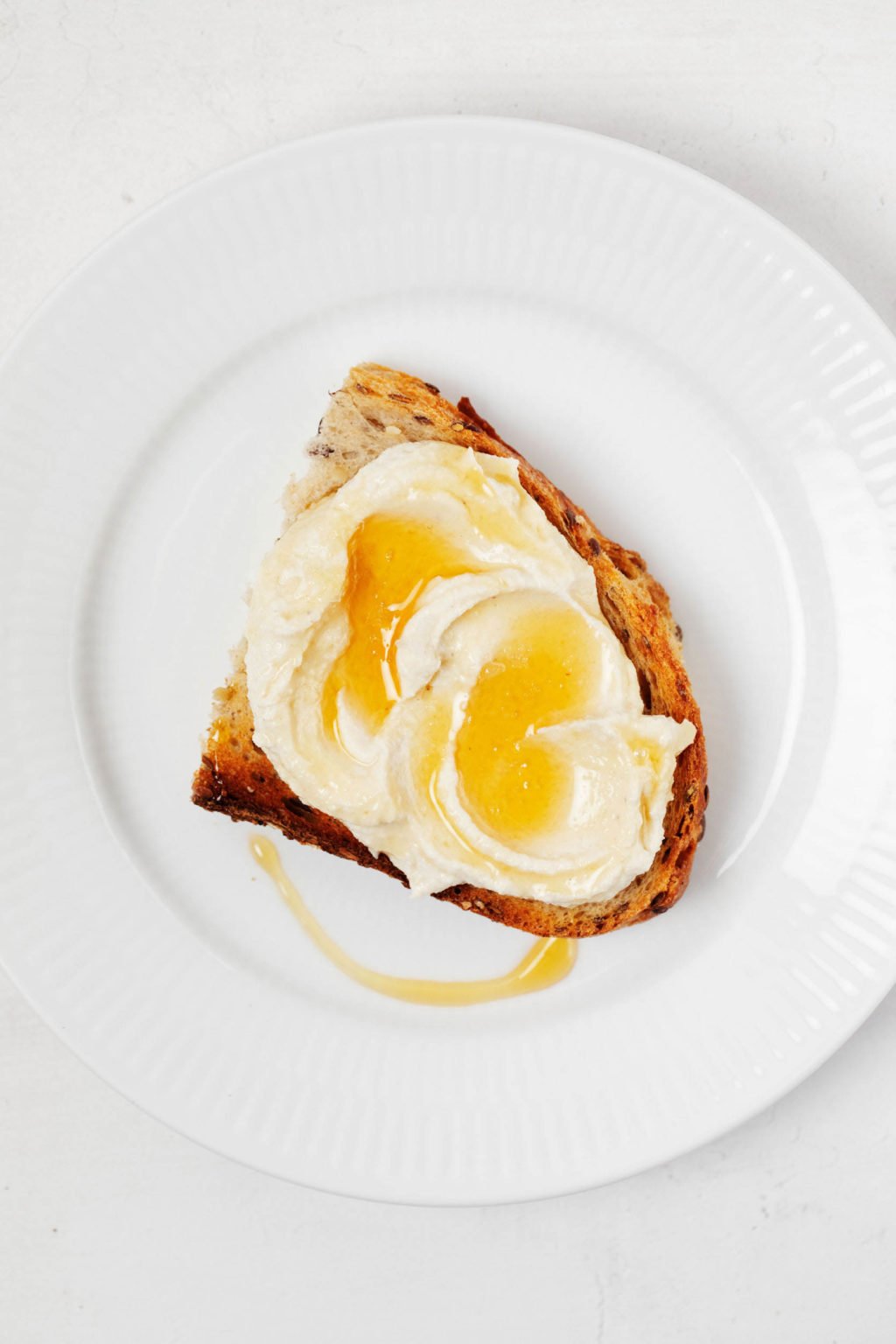
This has been the season of staples.
As you’ve probably gathered from my recent blog posts, I’m not doing a lot of cooking. When I do cook—once weekly, as part of my Sunday meal prep—I’ve been sticking to recipes that I know and love. There will soon be more time to experiment with new food, and I’m excited for that.
But for now, I’m relying on what’s tried-and-true. For example, rice, beans, tofu & greens, skillet lasagna, creamy mushroom pasta, mac and cheese, and my warm winter squash bowl (it’s no longer winter, but it’s still chilly!).
I’m also relying heavily on staples. I don’t think I’ve ever been more grateful for homemade vegan dressings, non-dairy cheeses, sauces, and simple proteins.
Having just one or two homemade staples in the fridge can transform a week of eating. A great sauce is the difference between a plain and a vibrant vegan skillet or bowl. A basic, homemade vegan protein can be served up in so many ways—over toast, in a bowl, on a salad, or with a bowl of soup.
I have a particular fondness for homemade vegan dairy alternatives. When I first became vegan, dairy was the thing that I missed most. As a result, I’ve put the most effort into homemade equivalents.
This ricotta is a favorite. It’s not new, exactly: it has evolved from past experiments and iterations. But it’s now my go-to vegan ricotta cheese, and it’s about time I shared the recipe on its own.
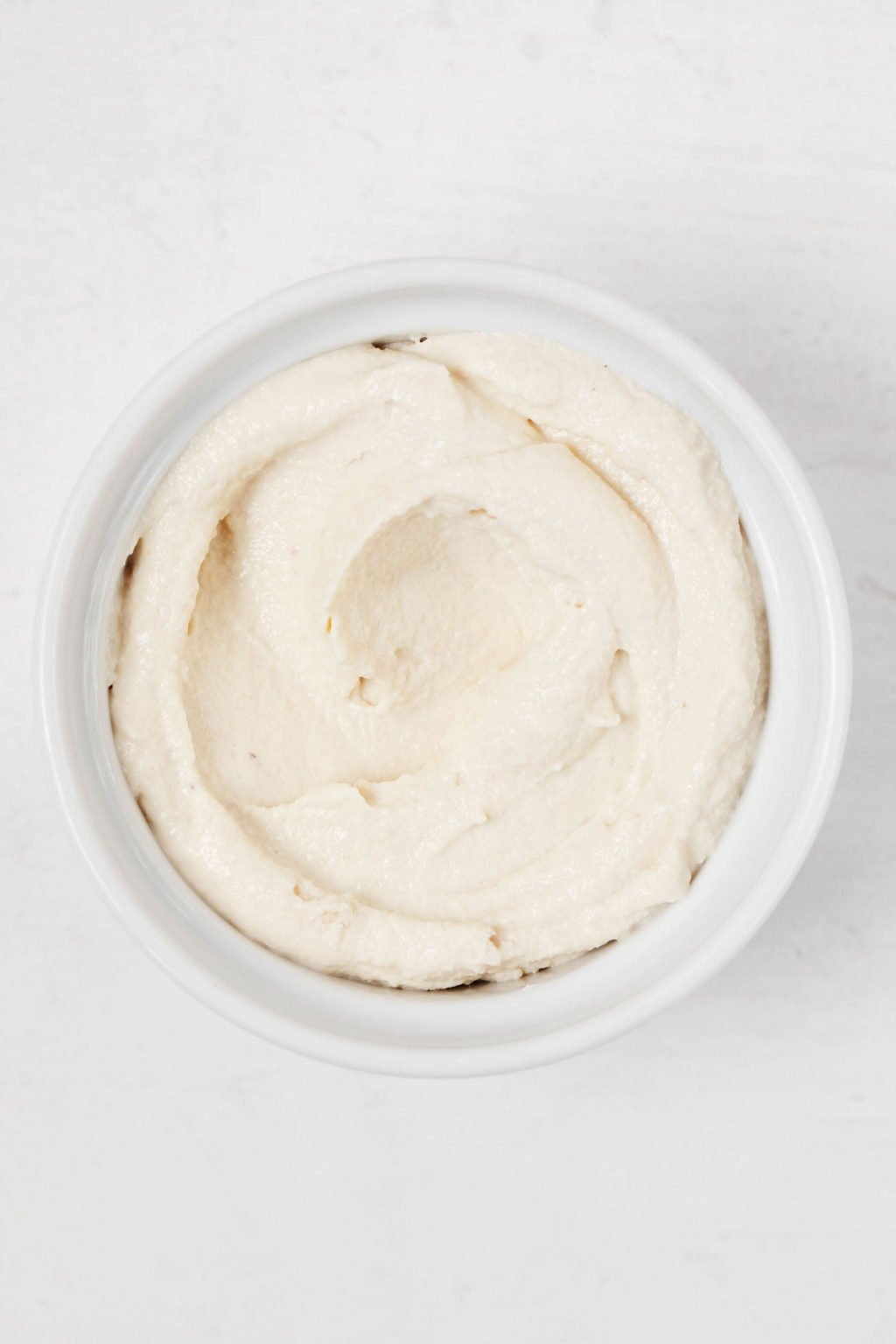
Cashews + tofu (the magic formula)
This vegan ricotta recipe grows out of others that I’ve tried. In particular, I’ve made past versions that were entirely cashew-based, similar to my go-to cashew cheese.
I’ve also made vegan ricotta using tofu. If you’ve tried the stuffed shells in Power Plates, then you’re familiar with the light, fluffy tofu ricotta and spinach mixture that fills them. I also use tofu ricotta in my summery eggplant rollatini.
Both cashew and tofu versions of vegan ricotta have their limitations, though.
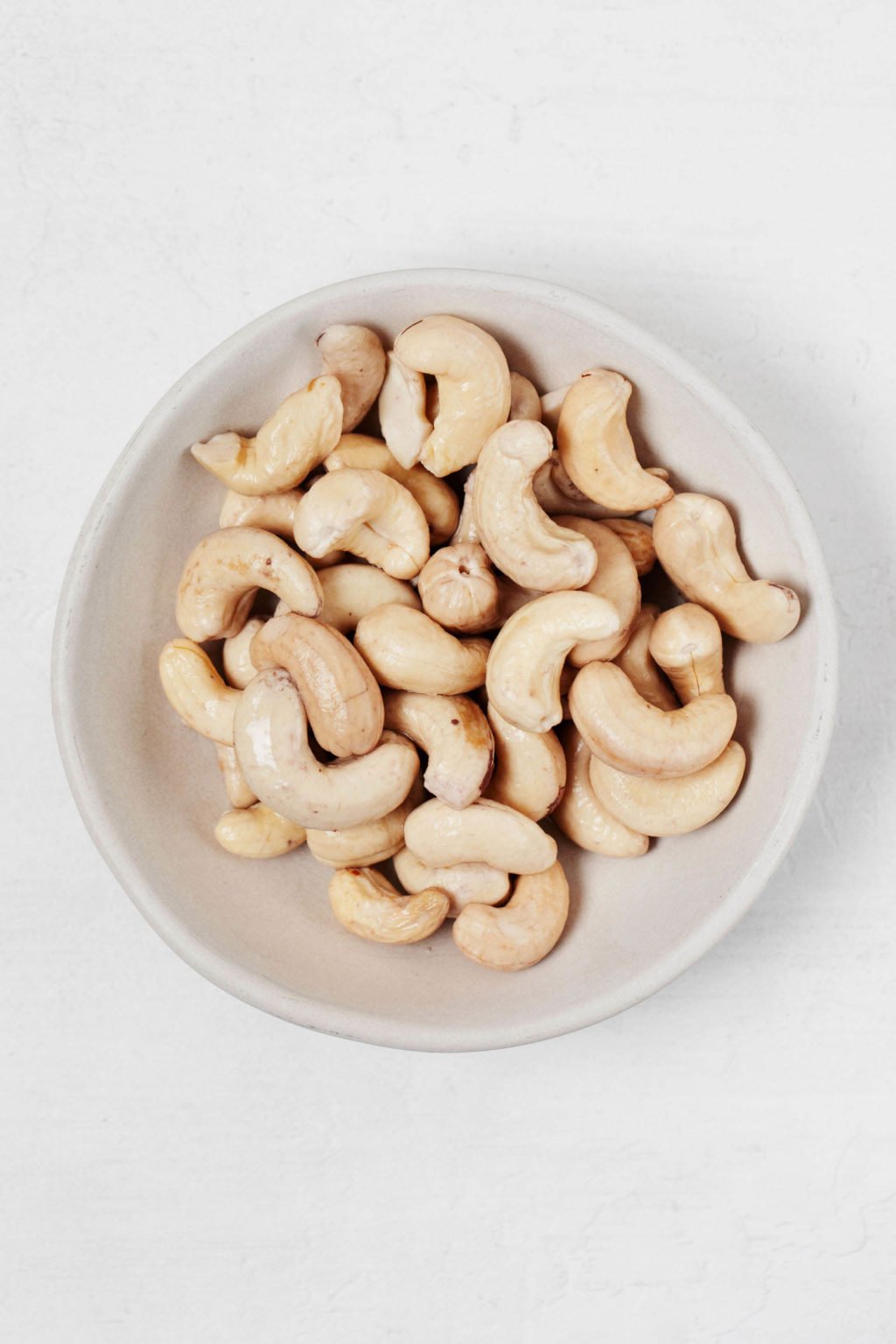
While cashews make for a wonderful, spreadable cheese—similar to goat cheese—the texture of cashew-based ricotta is almost too dense to be authentic. Ricotta has a lightness to it, a whipped consistency, and cashews can become ever-so-slightly gluey when you blend them up.
On the other hand, tofu ricotta has lightness, but it doesn’t have the richness that you find in regular ricotta. On its own, tofu is pretty low in fat, so it’s tough to achieve creamy consistency and mouthfeel with it.
Cashews + tofu, though? Perfection.
Blending up cashews with tofu results in the vegan ricotta of my dreams. It’s rich, yet light; fluffy, but not crumbly.
This dynamic duo is now the base of the vegan ricotta that I’m sharing today, and which I use in so many recipes. It goes into my beloved vegan spinach lasagna rolls and my eggplant baked rigatoni, to name only two.
But I also spoon it on top of pasta + store-bought marinara when I’m feeling a little lazy. I add it to homemade vegan pizza. I fold it into salads; it’s especially nice with this lentil beet salad.
And, as you can see in some of the photos in this post, I Iove to spread the ricotta on a piece of toast, then drizzle it with agave syrup and finish it with a few flakes of Maldon sea salt.
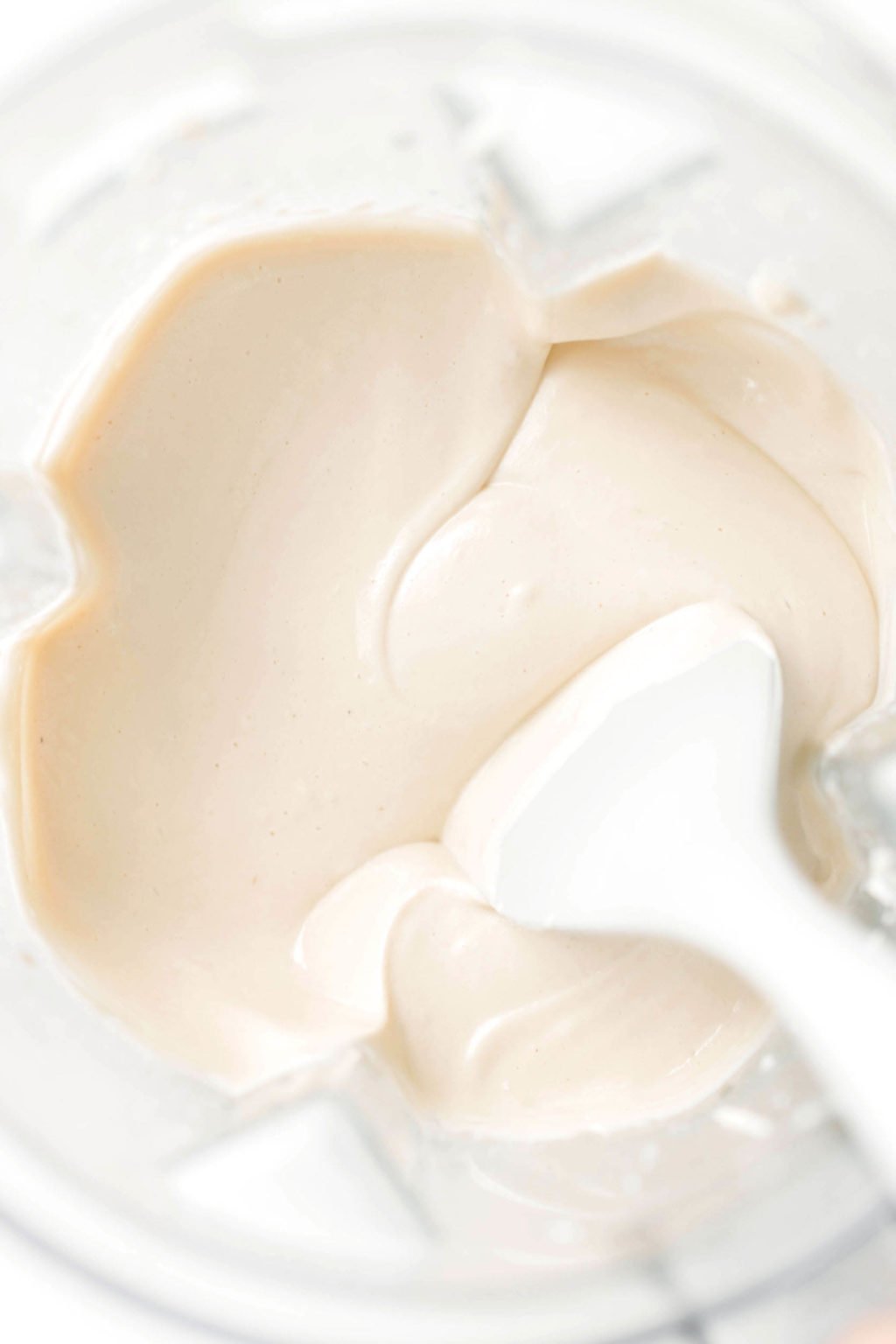
While vegan ricotta is my focus today, it’s worth saying that the potential of cashews + tofu doesn’t stop here. I also use cashews along with silken tofu, rather than extra firm, to make my favorite vegan whipped cream!
How to make 10 minute vegan ricotta cheese
The process of making this vegan ricotta is so simple—hence the speedy preparation time.
You’ll start by pre-soaked cashews in a food processor fitted with the S blade, along with the seasonings for this recipe (lemon juice, salt + pepper, nutritional yeast, garlic powder).
You don’t need to blend the cashews thoroughly here. Just process them for a minute, or until they’ve been broken down and no large pieces remain.
Then, you’ll crumble your extra firm tofu into processor. I like to press my tofu while I’m soaking the cashews, so that it doesn’t add too much moisture to the ricotta. Pressed texture = fluffier vegan ricotta cheese.
At this point, you can continue to process the ricotta for a couple minutes. Stop a few times and scrape down the bowl of your food processor as you go.
At the end of this process, you’ll have a smooth, spreadable, light vegan ricotta. Taste the cheese, season it with extra salt or lemon as needed, and store it or start to enjoy it in recipes.
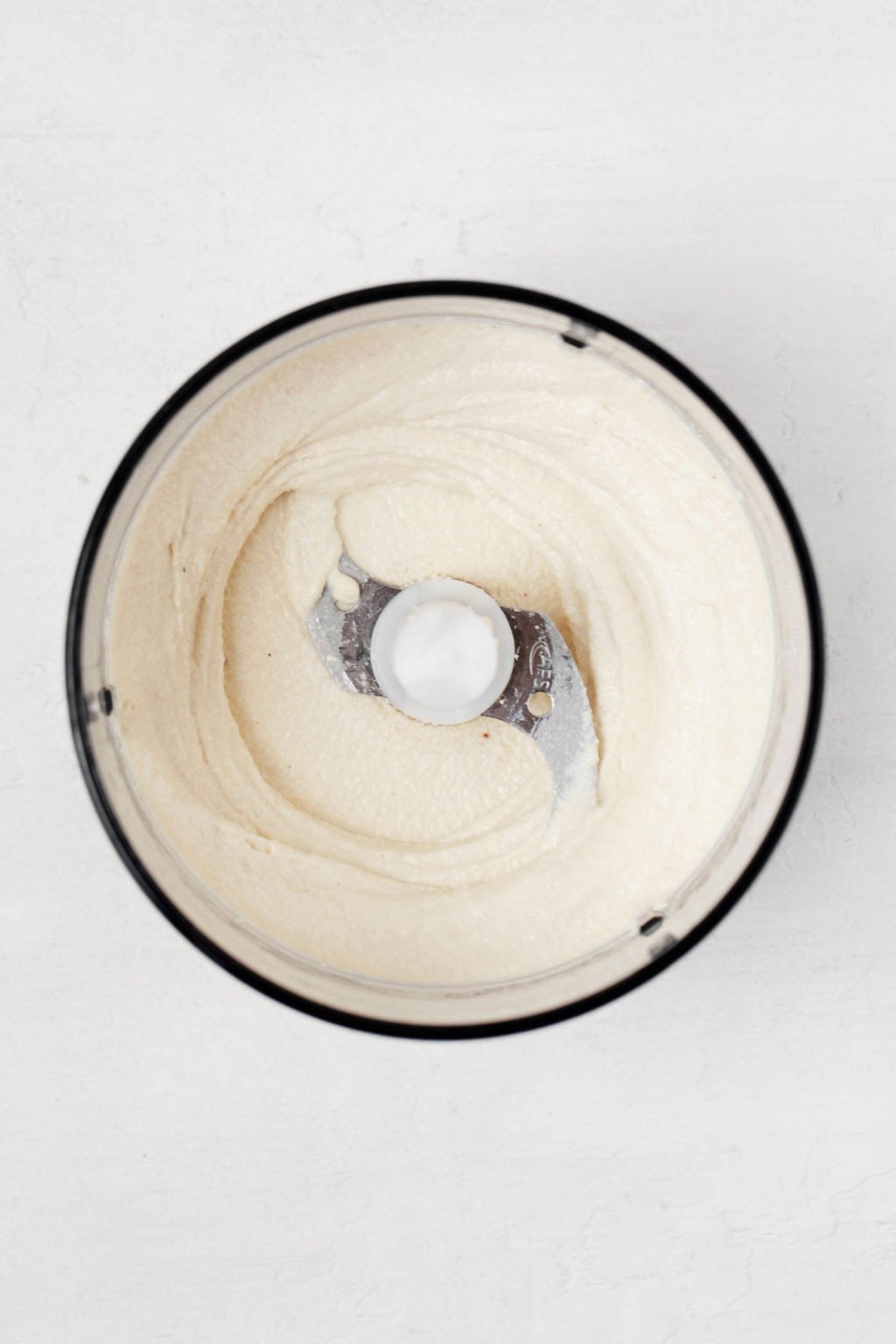
Do I have to soak my cashews?
In a word, yes. But there’s the option of a shortcut, if you need one.
Soaking cashews softens them slightly, so that they become easier to blend and process. It makes a big difference in preparing the recipe.
The good news is that you don’t have to soak your cashews for very long. If it’s easiest for you to pop them in the fridge and soak overnight, that’s fine. But 2 hours at room temperature does the trick.
If you’re in a rush, you can also bring a pot of water to boil, then pour the piping hot water over your cashews. Cashews that have been soaked in hot water like this will be ready for blending in just 30 minutes—a good, time-saving option when you’re in a rush.
What type of cashews should I use?
For this recipe, as well as my go-to cashew cheese, I use what’s labeled as “raw” or “unsalted and unroasted cashews.”
Technically, these cashews have actually been roasted once, after they’re shelled, in order to make them edible. But cashews that have been prepared this way are sold as “raw” in the sense that they’re not seasoned, and they don’t taste as if they’ve been toasted.
Tofu pressing 101
The extra-firm tofu that I use in the vegan ricotta should be pressed, if you have the opportunity to do that while your cashews soak.
Pressing tofu is easy. You can certainly use a commercial tofu press, if you like. I have one, simply because I cook with tofu very often.
But it’s easy enough to press tofu with plates or cutting boards. This post has some easy instructions.
Speaking of tofu, I generally use extra-firm tofu for my vegan ricotta cheese. However, regular firm tofu will also work in the recipe, if that’s what you have on hand.
Can you recommend a cashew substitute?
I rely on cashews for so many of my non-dairy staples. They’re neutral in flavor, which makes them versatile. They’re a source of healthful fats, and unlike traditional dairy or coconut, they’re low in saturated fat.
Best of all, cashews create wonderfully creamy and luxurious textures in plant-based cooking.
At the same time, I know that some of my readers have cashew allergies, which makes me feel badly about my cashew reliance!
If you’re allergic to cashews, but you can tolerate other nuts, then I recommend using pine nuts or macadamia nuts for this recipe and others.
If you’re allergic to all tree nuts, then my regular (cashew-free!) tofu ricotta will serve you well.
How long can I store vegan ricotta cheese?
The vegan ricotta should be stored in an airtight container in the fridge. It will keep for up to four days this way.
Can I freeze vegan ricotta?
Absolutely! Note that the texture of the ricotta might separate a little and become slightly less creamy after defrosting. This is normal, and it’s OK—the ricotta will still lend itself to great pasta dishes and more.
The vegan ricotta can be frozen for up to 6 weeks.
How to serve vegan ricotta cheese
Basically, you can serve this dairy-free ricotta in any of the ways you’d use traditional ricotta: as a spread, in pasta, etc.
Looking for more ideas? Here are some of the recipes that I like to use my vegan ricotta in or on.
- Eggplant baked rigatoni
- Spinach lasagna rolls
- Beans & greens pasta
- Lemon orzo pasta salad
- One-pot Italian quinoa and lentils
- Creamy vegan skillet lasagna
- Cozy vegan cauliflower gratin
- Lentil beet salad
- Braised lentils on toast
- Vegan pasta alla vecchia bettola
- Simple, vegan burst cherry tomato pasta

10 Minute Vegan Ricotta Cheese
Author –Ingredients
- 3/4 cup raw cashews (105 g)
- 1 tablespoon freshly squeezed lemon juice
- 2 tablespoons nutritional yeast
- 1 teaspoon salt (or to taste)
- 1/4 teaspoon garlic powder (optional—not traditionally in ricotta, but nice if you add the cheese to pasta dishes)
- Pinch freshly ground black pepper
- 14-16 ounces extra firm tofu, pressed for at least 1 hour to remove moisture (1 standard-sized block tofu)
Instructions
- Submerge the cashews in enough water to cover them by a few inches. Soak them for at least 2 hours, or transfer them to the fridge (uncovered is fine) and soak them overnight. Drain the cashews and rinse them before proceeding.
- Place the cashews into a food processor fitted with the S blade. Add two tablespoons water, lemon juice, nutritional yeast, salt, garlic powder, if using, and black pepper.
- Pulse a few times, then process for about a minute, to break the cashews down.
- Crumble the tofu into the processor.
- Continue processing all ingredients for another 2 minutes, stopping a few times to scrape the sides of the processor down. When the ricotta is completely creamy and smooth, stop the processor. Taste and adjust the salt/pepper/lemon to your liking. Serve as desired or store in an airtight container in the fridge for up to 4 days.
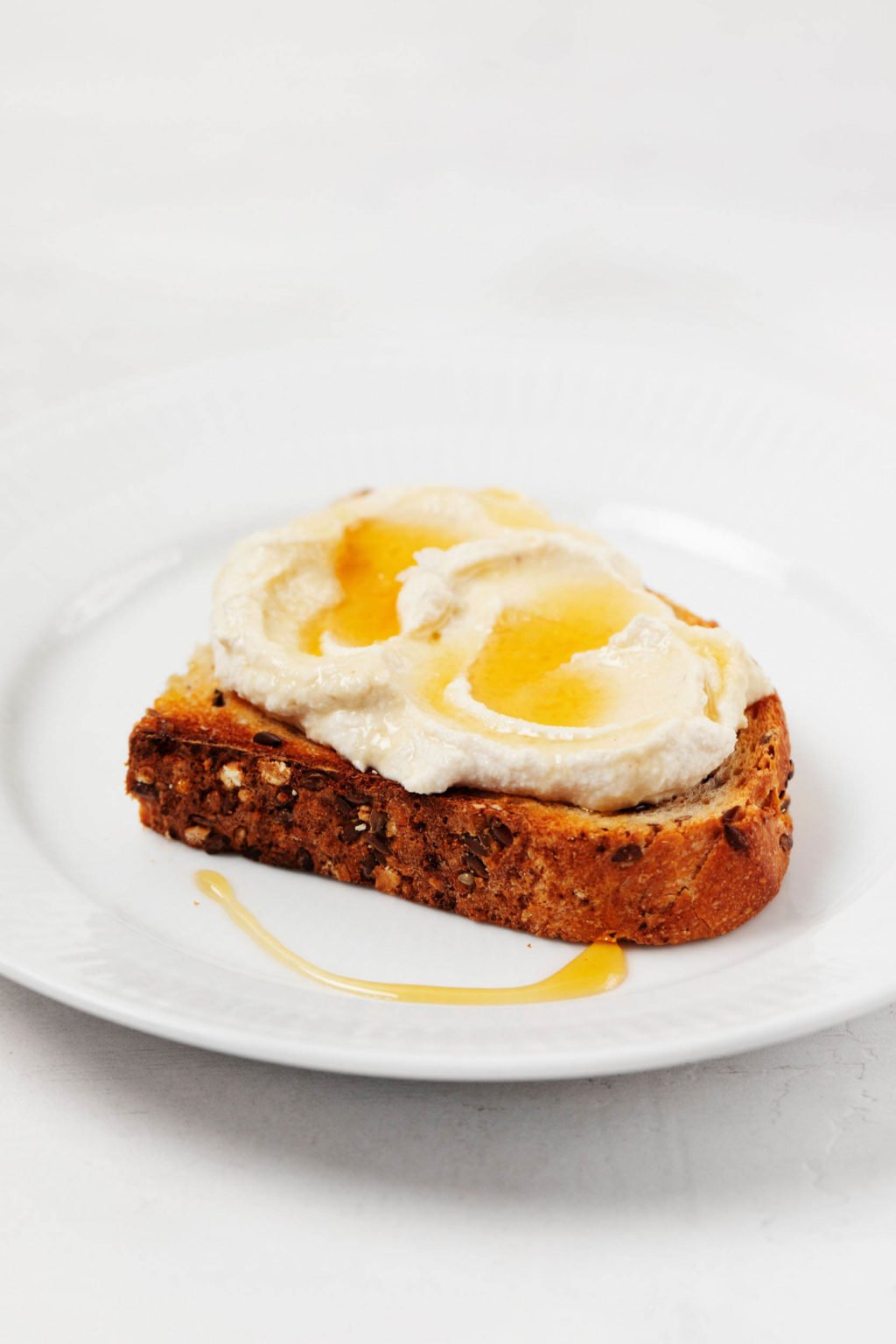
I’ve been thanking this community lately for sticking around and being supportive while my weekend reading posts are abridged (or even skipped).
In the same way, I’m grateful to all of you for tuning in even when my cooking is limited to staples and basics. I know how busy everyone is, and I know that many of us feel weary. So my hope is that these simple recipes feel as useful to you as they do to me.
If you’re looking for more basics, there’s cashew cheese, tofu cream cheese, date-sweetened BBQ sauce, yellow cheese sauce, cashew mozzarella, cashew parmesan, and much more to explore around here.
And I’m sure I’ll have a few more staples to share before this busy season ends! For now, friends, enjoy this easy vegan cheese.
xo
This post may contain affiliate links. If you use these links to buy something I may earn a commission. Visit my privacy policy to learn more.
Ingredients: Cashew Nuts, Tofu
Dietary Preferences: Gluten Free, Vegan
Recipe Features: 30 Minute or Less, Quick & Easy

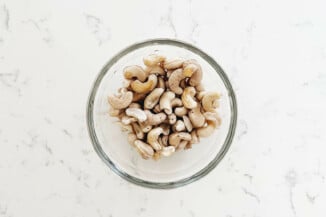
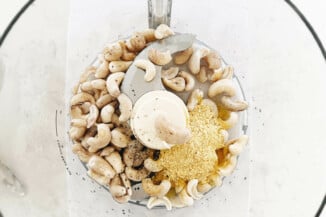
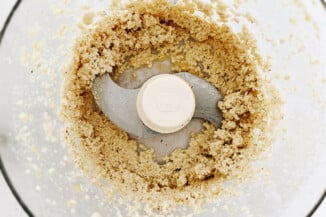
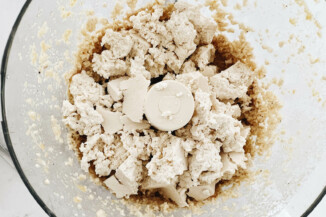

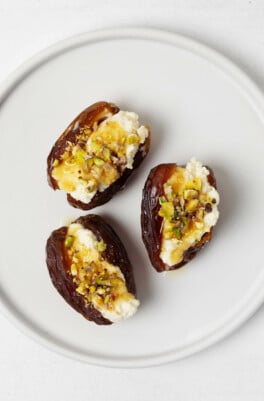
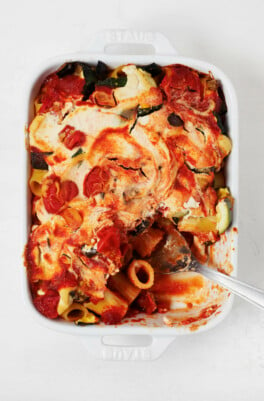
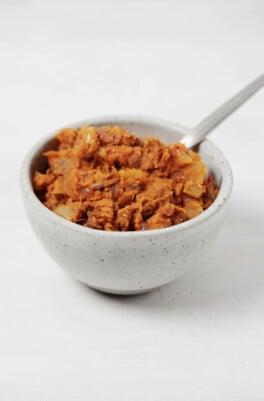
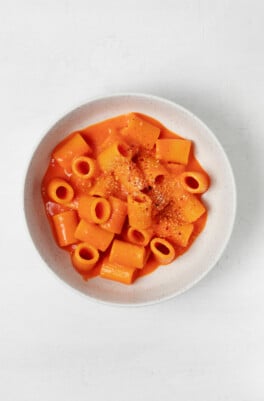
Leave a Comment
I made this for my family (who are not so vegan friendly!!) they loved it!! Big hit!! Thank you so much!!
Hooray! So glad it was a hit, Libby!
Hi! I will try this next week. I´m just curious – what purpose have the yeast? I´m not sure what to buy here in Sweden…
Hi Minna,
It adds a “cheesy” flavor. It’s a very nice addition, but it’s not absolutely necessary if you can’t find it. From what I understand, nutritional yeast is available in most parts of Europe.
Hope you enjoy!
Made this recipe as specified and it just tastes like tofu. I’d definitely cut the amount added in half.
Wow I’m so glad I came across your recipe. It’s a convergence of the two worlds of creamy cheesy goodness I’ve been trying to achieve. I sliced up some nectarines for mine! Also I added in 2 tablespoons of a homemade fermented pickle liquid and adjusted the salt with miso. Grateful for delicious snacks like these, so many ways to add extra flavor on creamy toasts!
Hi Meggie, hooray! I have the very same feelings about this recipe. Hope you’ll continue to enjoy it.
Can you please tell me how much ricotta this makes by volume to assist in adapting recipes? For example, I have a Re pie that calls for 2 cups ricotta that I would like to adapt for a vegan friend. Thank you.
Hi Barb! It makes about 2 1/4 cups. So it should work well for a 2-cup recipe 🙂
I made your whipped cream with tofu and cashews this week (and the choc puddings!) and it was fantastic. Can’t wait to make this. I’m on a soft diet for a week or so after a dental procedure, and there are a lot of great recipes on here that I can eat. Also thankful for the lists of ideas you give at the end of each recipe.
(Yellow cheese sauce on very softly steamed veggies and baked potatoes coming up next!)
Thanks for everything you share, Gena. It’s much appreciated!
If making this to serve with fruit would you recommend leaving the garlic out? Or still keeping it in? Thank you for all the wonderful recipes and inspiration!
Oh, I think it would be lovely with fruit! I’d leave the garlic out, personally—and in fact, I’m going to make it optional, since it’s not exactly traditional in ricotta (just nice when you use the ricotta in pasta). Thanks for making me think of it